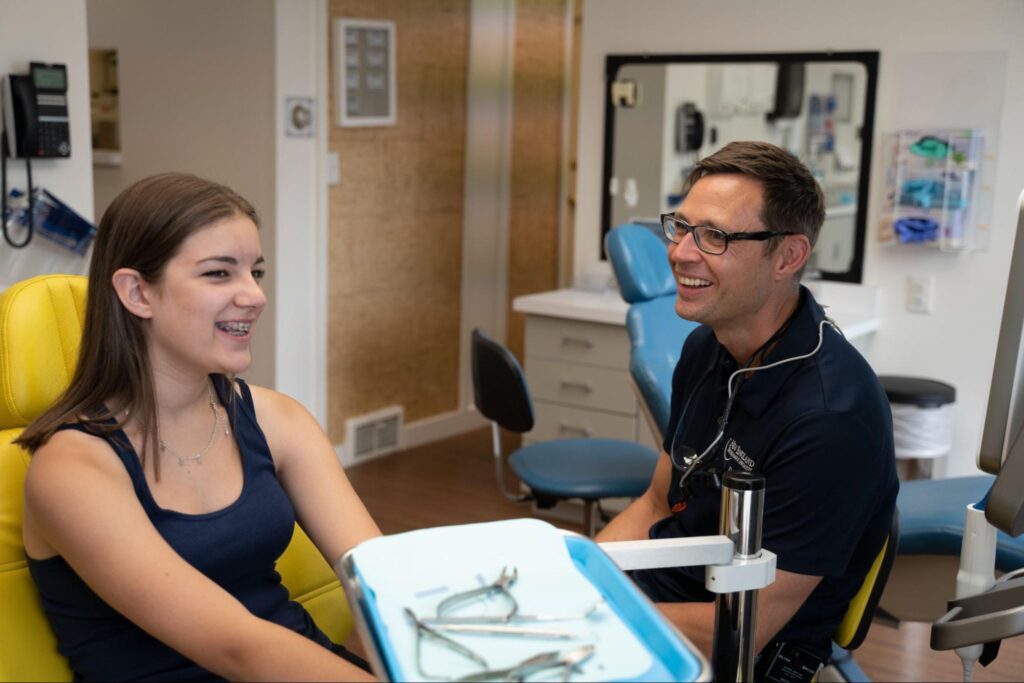If your jaw pops, aches, or feels stuck, you might be dealing with a problem involving the temporomandibular joint (TMJ). This joint acts like a sliding hinge on each side of your jaw, letting you talk, chew, and yawn. When something’s off, you can experience pain in your jaw, headaches, or even earaches. People sometimes wonder if orthodontic treatment from Dr. Neilor Dr. Dianacan help ease TMJ issues. By the end of this blog, you’ll have a clearer idea of whether braces are right for you or your child. We offer comprehensive care in Beverly,Topsfield, Hamilton, Salem, and Lynnat New England Orthodontic Specialists. We’re ready to help you figure out the best path toward a healthier smile and a happier jaw.
What Is a TMJ Disorder?
TMJ disorders—often called TMD—affect the hinge that connects your jawbone to your skull. You have two joints on each side of your face, just in front of your ears. They allow your jaw to slide up, down, and side-to-side.
When you have TMD, you might notice:
- Jaw popping or clicking
- A dull ache or soreness near your ear or jaw
- Tightness around the jaw muscles
- Trouble chewing
- Pain that spreads to your neck or shoulders
Many things can set off TMD. Dr. Diana and Dr. Neil noticed that one factor is teeth grinding (bruxism). Stress can tighten facial and jaw muscles. Bad bite alignment—where teeth don’t fit together properly—may strain the TMJ. Sometimes, a minor injury to the jaw can spark TMD. Hormones, arthritis, and even certain habits like gum chewing could contribute to this.
How Braces Connect to TMJ Health
You might not think your teeth affect your jaw, but everything in your mouth is closely linked. When your bite is off, your jaw may shift to make your teeth fit together. Over time, that extra strain can irritate the TMJ and muscles around it.
Bracesfrom New England Orthodontic Specialists can help by straightening and realigning your teeth. When your top and bottom teeth meet in a more balanced way, your jaw doesn’t have to work as hard. With less stress on your jaw, you might see fewer TMD-related issues.
It’s important to note that not every TMJ problem comes from bad tooth alignment. For some people, TMD might be rooted in muscle tension or a past injury. In those cases, braces may or may not help. It all depends on what’s causing your trouble in the first place. That’s why an in-person evaluation with an orthodontist is so valuable.
Signs That Alignment Might Be a Factor
You may be asking yourself how to tell if your TMJ issues come from a bad bite. While only trained professionals like our New England Orthodontic Specialists team can diagnose bite-related problems, here are a few common signs:
- Clenching or Grinding
- You might notice jaw pain in the morning if you tend to clench or grind your teeth at night. This habit can wear down your teeth and throw off your alignment.
- Difficulty Biting or Chewing
- When your teeth don’t line up, biting into a sandwich or chewing tough foods might be tougher than it should be.
- Jaw Swings to One Side
- You might notice that your jaw shifts to the left or right when you open or close your mouth.
- Uneven Tooth Wear
- Teeth that meet in odd spots can wear down faster. You might notice flattened or chipped areas on one side of your mouth more than the other.
If any of these ring a bell, braces could help correct how your upper and lower teeth line up. As your alignment improves, you may see progress in your TMJ health, too.
What Happens If You Do Nothing?
Some TMD symptoms come and go on their own, especially if the cause is mild. Resting your jaw, switching to softer foods for a while, or practicing stress management can calm things down. But if your alignment is off, ignoring the situation might lead to bigger problems. You could be looking at more pain, tooth damage, and even changes in your facial structure over time.
If you’re in the North Shore area—Beverly, Topsfield, Hamilton, Salem, or Lynn—and TMD affects your daily life, it might be time to schedule a consultation with Dr. Diana or Dr. Neil.
How Braces Work to Improve Alignment
Metal and ceramic braces move your teeth step by step to a better position. Small brackets attach to each tooth, connected by a thin archwire. Over time, gentle pressure from the wire and elastics shifts your teeth. As your bite becomes more balanced, you should find it easier to open and close your jaw.
Timeline
- Consultation: You’ll meet with our teamto see if braces are a smart option for your TMD.
- Placement: We’ll place brackets on your teeth, and the initial wire will be attached.
- Adjustments: You’ll visit every few weeks for adjustments so your braces keep putting the right pressure on your teeth.
- Monitoring TMD: During your visits, mention any changes in jaw pain or clicking. Dr. Diana and Dr. Neil can trackhow your TMJ is responding to treatment.
- Debonding: After your teeth reach the desired positions, your braces will come off.
At that point, you’ll wear a retainer to keep your teeth in the proper spots. Consistent retainer wear is key if you want to maintain the benefits for your bite and jaw.
Common Questions About Braces and TMJ
Need to know more about TMJ treatments at New England Orthodontic Specialists? Here are some of the most common questions we get.
1. Will braces hurt my jaw more?
It’s normal for your teeth and gums to feel a little sore after you get braces or adjustments. But it’s usually short-term. Many people with TMD find that braces don’t make their jaw pain worse. In fact, the long-term improvements often outweigh any short-term discomfort.
2. How long do I have to wear braces to help my TMJ issues?
Every person’s mouth is different. Mild alignment concerns can take under a year to fix, while more complex cases might need two or more years. Your orthodontist will give you an estimated timeline after examining your bite.
3. Do I have to wear retainers forever?
You’ll probably wear retainers full-time for a few months after braces, then switch to nighttime only. It’ll help keep your teeth from drifting back to their old positions. If you stop wearing your retainer too soon, your bite—and possibly your TMJ issues—could return.
4. Can I get Invisalign instead of braces?
Dr. Neil and Dr. Diana use Invisalign. It’s a clear aligner system that also shifts your teeth, but not everyone with TMD is a good fit. Some complex cases do better with traditional braces. Our team can let you know which option is best for your jaw and overall dental health.
5. Do kids have a lower chance of TMD?
Kidsand teenscan develop TMD, especially if they have an overbite or underbite that puts extra strain on the jaw. Early orthodontic treatment could help reduce or head off jaw problems down the road. If you notice your child complaining about jaw pain or noises, ask our team for an opinion.
Ready to Feel Better?
At New England Orthodontic Specialists, we’re here to help you sort out the best treatment path for TMD. With offices in Beverly, Topsfield, Hamilton, Salem, and Lynn, you have convenient choices around the North Shore. Dr. Diana and Dr. Neil are dedicated to giving you the support you need through every step of treatment. If you’re ready to explore the options and see if braces can help you, give us a call or schedule a consultation.


